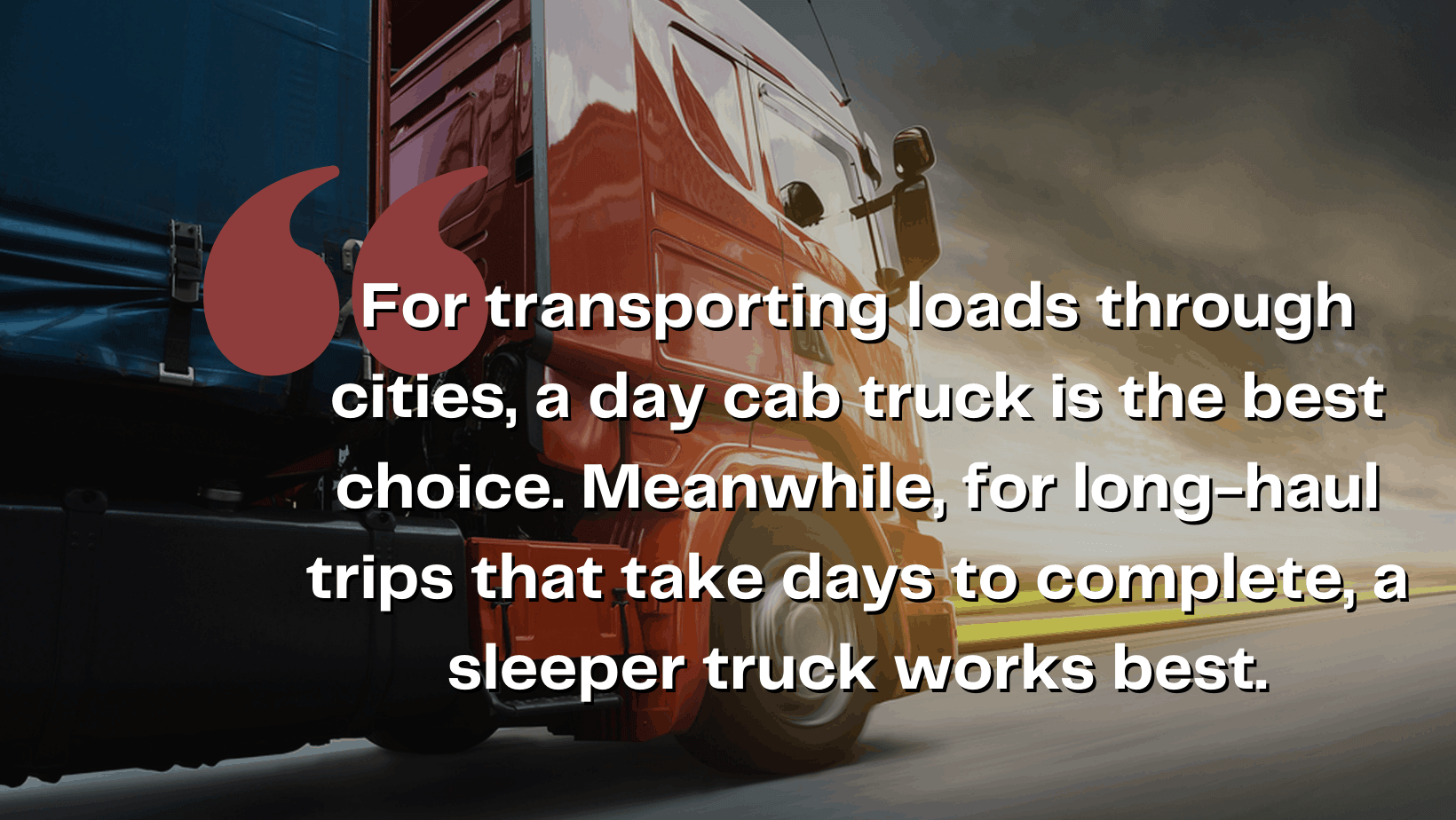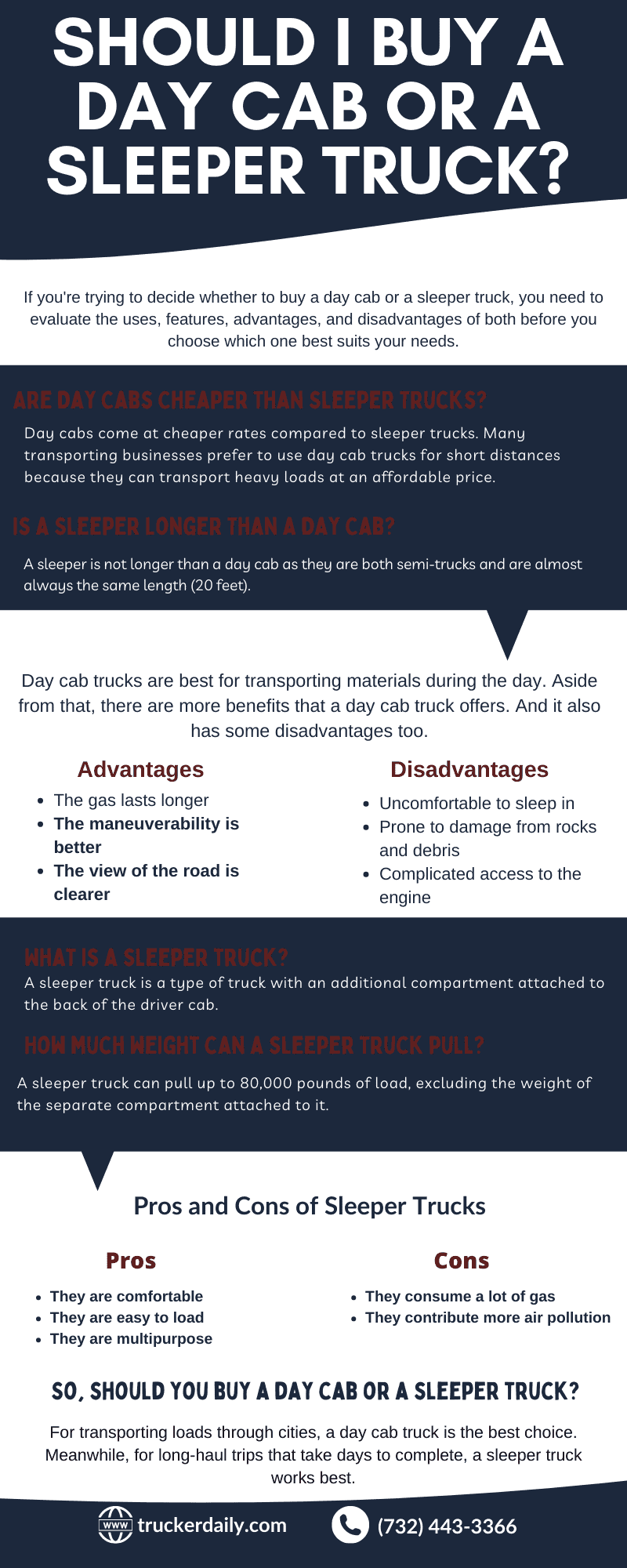A day cab and a sleeper truck are two different rigs that are both used to pull a large trailer. Both are semi-trucks and are commonly used to deliver heavy loads. But if you only need to choose one, should you buy a day cab or a sleeper truck?
If you're trying to decide whether to buy a day cab or a sleeper truck, you need to evaluate the uses, features, advantages, and disadvantages of both before you choose which one best suits your needs.
Their engines are over 6 times larger than normal road cars. This means both the day cab and sleeper truck can carry out some similar functions and serve major purposes for quite some time.
The typical dimensions of a sleeper truck and a day cab are 13.5 feet high, 72 feet long, and 8.5 feet wide. Weighing up to 80,000 pounds, both semi-trucks have a high towing capacity.
Although both trucks are very similar, they both have distinct features that enable them to function differently.
Let's take a look at everything you need to know about day cabs and sleeper trucks.
Are Day Cabs Cheaper Than Sleeper Trucks?
Day cabs come at cheaper rates compared to sleeper trucks. Many transporting businesses prefer to use day cab trucks for short distances because they can transport heavy loads at an affordable price.
For this reason, it is common to see day cab trucks on the road in busy business areas.
A day cab is a form of truck without a sleeper cabin or compartment connected to its back. It consists of just a single compartment, which is over and behind the engine part of the truck.
This truck is usually used to transfer retail cargo to a specific location that's a short-haul away.
When it comes to transporting heavy cargo on a short journey, a day cab truck is the best bet. A day cab truck can accommodate a weight capacity of 65,000lb of load.
Is a Sleeper Longer Than a Day Cab?
A sleeper is not longer than a day cab as they are both semi-trucks and are almost always the same length (20 feet).
With the absence of an attached sleeper trailer, using a day cab to transport products on long journeys would possibly be uncomfortable for the driver or detrimental to the state of the cargo that's being transported.
When the day gets dark, the drivers might not be able to rest properly if they try to sleep in the driver's seat. Plus, the truck's cargo would not be fully shielded from external factors that could damage it.
This is unlike a sleeper truck, which has an extra compartment where the driver can rest, relax and sleep.
The most advanced on-highway truck @Freightliner has ever offered, the #NewCascadia #DayCab pic.twitter.com/P149EYmaTH
— Advantage Truck Group (@WeKnowTrucks) July 30, 2021
Advantages and Disadvantages of Day Cab Trucks
Day cab trucks are best for transporting materials during the day. Aside from that, there are more benefits that a day cab truck offers. And it also has some disadvantages too.
Let's take a look at each one in detail:
Advantages of Day Cab Trucks
- The gas lasts longer
In comparison to other hauling trucks, a day cab truck has a lighter chassis. This allows the vehicle to run on less gas. This means that with a day cab truck, you can haul a heavier shipment without quickly burning through gas.
- The maneuverability is better
Due to the length and short cab of a day cab truck, maneuvering in narrow corners and through sharp turns in the road is a breeze.
A day cab truck has a 30% to 40% tighter turning radius than other trucks, which gives it the ability to maneuver smoothly on tight driveways.
- The view of the road is clearer
A day cab truck provides the driver with a clearer view of the road while driving.
The driver seat of a day cab truck is close to its large windshield, which offers crystal clear visibility of other cars on the road and the roads ahead.
There are also windows at the back bonded with the trucks' rear frame. This gives the driver a clear view when backing up on the road.
Disadvantages of Day Cab Trucks
Just like with every other truck, a day cab truck has its disadvantages.
- Uncomfortable to sleep in
Truckers in a day cab truck, who happen to still be on the road when night time comes, might have difficulty sleeping inside the truck.
The space of a day cab truck can allow for sleeping, but there isn't much comfort, unlike other, larger trucks.
This is because the day cab truck cabin sits directly on top of the engine, leaving little room to stretch out inside.
- Prone to damage from rocks and debris
The day cab truck has a large windscreen with no hood. This makes the truck vulnerable to being hit by rocks or debris while on the road.
Hoods help to protect the windscreen of a truck, and as a result, protect the driver too.
- Complicated access to the engine
Day cab truck engines are below the driver's seat. They can only be accessed when the driver's seat area is turned over.
So whenever a repair or maintenance check is needed, the seat will need to be flipped up to access the engine.
The entire process can be difficult, especially when repairs have to be carried out and the engine needs to be started simultaneously.

What is a Sleeper Truck?
A sleeper truck is a type of truck with an additional compartment attached to the back of the driver cab.
The additional compartment is called a sleeping berth. Originally, sleeping berths were made for train occupants traveling overnight.
In 1967, truck manufacturers came up with a sleeper truck design for truck drivers who needed to spend days on the road while transporting loads from one state to another.
These trucks are used to transport goods to far places. Also, there is a separate area in the truck's cabin for the driver to sleep and to rest from driving.
With a sleeper truck, a driver might not need to stay in a hotel to rest after driving.
For trips that take days before the trucker arrives at their destination, a sleeper truck can help provide reasonably comfortable accommodations at no extra cost.
Some sleeper trucks function as mobile apartments. They contain basic household features such as a kitchen, fridge, bathroom, and storage compartments where the trucker's belongings can be kept.
You don't want to miss out on this used 2018 @WesternStar #5700XE powered by a Detroit #DD15 505HP Engine, and Detroit #DT12 Transmission. Make your long hauls better with a 126″ Cab and 68″ HR Stratosphere Sleeper. Find out more: https://t.co/9WyBJ67D4h pic.twitter.com/xglCHIZsod
— First Truck Centre (@First_Truck) August 6, 2021
How Much Weight Can A Sleeper Truck Pull?
A sleeper truck can pull up to 80,000 pounds of load, excluding the weight of the separate compartment attached to it.
A sleeper truck provides the driver with a separate compartment where the driver can sleep, unlike a day cab that has none.
Other factors differentiate the two from each other. Here are more:

Pros and Cons of Sleeper Trucks
Sleeper trucks have specific features that are beneficial to truckers. Some of these benefits are:
Pros
- They are comfortable
The separate compartment attached to a sleeper truck functions as a resting area for drivers.
This gives the trucker the option of designing and installing basic features suitable to their liking.
Drivers can install custom lighting, air conditioning, and even a TV. This is a huge advantage over other trucks that have no extra space.
- They are easy to load
Sleeper trucks are easier to load and unload because their trailers are detachable. The sleeping compartment can also be removed and upgraded at any time.
- They are multipurpose
Sleeper trucks can carry huge loads and also function as mini-apartments for the driver. This makes the truck a home away from home during long-haul drives.
Cons
A sleeper might seem like a perfect all-around truck, but there are some downsides to them as well.
- They consume a lot of gas
Unlike a day cab trailer, sleeper trucks consume a lot of gas.
Most of the special upgrades contained in the sleeper compartment are connected to the truck's operating system. This means they also contribute to the fast consumption of gas.
- They contribute more air pollution
Sleeper trucks have environmental issues. Sometimes sleeper trucks expel a lot of dirty exhaust when the trucker hasn't used it in a while, and this pollutes the atmosphere.
So, should you buy a day cab or a sleeper truck?
At the end of the day, your decision to buy either a day cab or a sleeper truck depends solely on the types of jobs you're planning to take on as a trucker.
For transporting loads through cities, a day cab truck is the best choice. Meanwhile, for long-haul trips that take days to complete, a sleeper truck works best.
